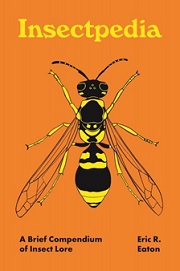Insectpedia: A Brief Compendium of Insect Lore

Eric R. Eaton
Princeton University Press, £9.99
Despite being only 171 x 114 mm, an almost unbelievable quantity of scientifically accurate and interesting information is packed in to the very readable Insectpedia.
Arranged alphabetically but with no index or contents list, it is fairly random which nugget you stumble on, especially as the alphabetical arrangement is somewhat idiosyncratic. ‘K’ is for Kissing Bugs not ‘A’ for assassin bugs, their alternative name, some species of which are vectors of Chagas disease. ‘K’ is also for Kinsey, Alfred C, the human ‘sexologist’ who studied gall wasps. Other entomologists make an appearance with ‘W’ for Wigglesworth, the ‘father of the study of insect physiology’ and holder, in 1952, of the wonderfully named Quick Chair of Biology at Cambridge. It is good to see that ‘C’ is for Collins, the first female, black American entomologist. Processes are also described, for example, ‘B’ for biocontrol, ‘N’ for neoteny and ‘S’ for seed dispersal and sericulture. Although published in the USA, entries range around the world, for example, Asian exploding ants and Australian beer bottle beetles.
The writing is crisp and at times humorous - "some insects are to dye for" says an entry under ‘C’ for cochineal, the red colouring made from crushed insects. The cloth cover, with an embossed wasp, is striking and the honeycomb pattern of the end papers are a nice touch. The delicate line & wash drawings by Amy Jean Porter are pretty, though lack detail.
It is hard to know who this book is aimed at. It should delight anyone who enjoys interesting facts and could generate desire for further study, hence would be good in school libraries. The most fun perhaps is trying to figure out how the author chose what to include. Despite some initial reservations, I ended up liking this book a lot.
Dr Sue Howarth CBiol FRSB


